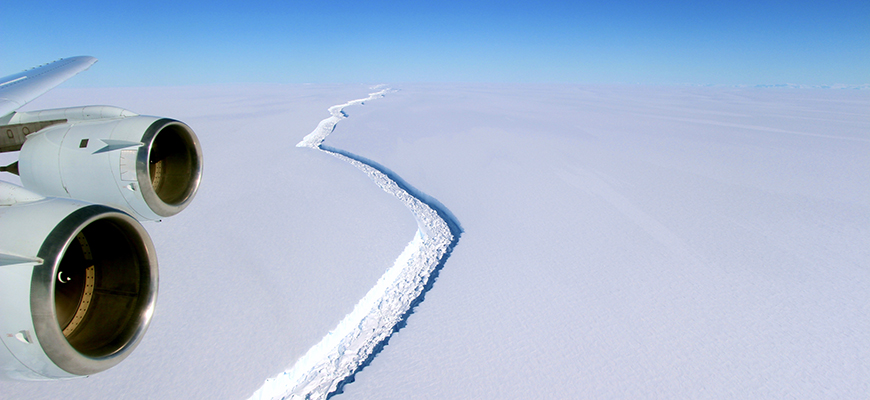Global S&T Development Trend Analysis Platform of Resources and Environment
| Special Notice: Statement from Scripps Oceanography Glaciologist on Larsen C Iceberg | |
| admin | |
| 2017-07-12 | |
| 发布年 | 2017 |
| 语种 | 英语 |
| 国家 | 美国 |
| 领域 | 资源环境 |
| 正文(英文) |  Larsen C crack in 2016. Photo: John Sonntag/NASA The Larsen C iceberg detachment taking place has drawn widespread attention because many in the public have speculated that it happened as a consequence of global warming. The dimensions of the iceberg, as large as the state of Delaware, lend a cataclysmic quality to what is happening, but glaciologists are not uniformly convinced this is cause for alarm. This is an example of events that are part of the constant maintenance of the rough mass balance of Antarctica’s cryosphere. The shedding of this particular iceberg compensates for the addition of snow Antarctica continually acquires. As new frozen material accumulates, it pushes ice off the continent. Some of this ice melts where it comes in contact with the ocean, and some of it breaks off as large icebergs every few decades. Our laboratory’s extensive research indicates that the calving of the iceberg, the changing surface height of the Larsen C Ice Shelf, and observed summer melt events are consistent with what glaciologists expect to happen as Antarctica responds to natural climate variability. Ice shelves, interacting with the dynamic atmospheric and ocean systems, are one element of the larger, complex climate system. This is not to take away from other areas in Antarctic that definitely merit alarm. Antarctic ice shelves overall are seeing accelerated thinning, and the ice sheet is losing mass in key sectors of Antarctica. Continuing losses might soon turn into an irreversible decline and several feet of damaging global sea level rise. However, as far as we can tell, this calving event for Larsen C is part of the normal evolution of an ice sheet. – Helen Amanda Fricker, glaciologist and professor of geophysics at Scripps Institution of Oceanography at the University of California San Diego. Fricker tracked the drift path of the 1986 Larsen C iceberg with passive microwave imagery, and has studied calving processes on other ice shelves since the early 2000s.
Note to broadcast and cable producers: University of California San Diego provides an on-campus satellite uplink facility for live or pre-recorded television interviews. Please phone or email the media contact listed above to arrange an interview.
About Scripps OceanographyScripps Institution of Oceanography at the University of California San Diego, is one of the oldest, largest, and most important centers for global science research and education in the world. Now in its second century of discovery, the scientific scope of the institution has grown to include biological, physical, chemical, geological, geophysical, and atmospheric studies of the earth as a system. Hundreds of research programs covering a wide range of scientific areas are under way today on every continent and in every ocean. The institution has a staff of more than 1,400 and annual expenditures of approximately $195 million from federal, state, and private sources. Scripps operates oceanographic research vessels recognized worldwide for their outstanding capabilities. Equipped with innovative instruments for ocean exploration, these ships constitute mobile laboratories and observatories that serve students and researchers from institutions throughout the world. Birch Aquarium at Scripps serves as the interpretive center of the institution and showcases Scripps research and a diverse array of marine life through exhibits and programming for more than 430,000 visitors each year. Learn more at scripps.ucsd.edu and follow us at Facebook, Twitter, and Instagram.About UC San DiegoAt the University of California San Diego, we constantly push boundaries and challenge expectations. Established in 1960, UC San Diego has been shaped by exceptional scholars who aren’t afraid to take risks and redefine conventional wisdom. Today, as one of the top 15 research universities in the world, we are driving innovation and change to advance society, propel economic growth, and make our world a better place. Learn more at www.ucsd.edu.
|
| URL | 查看原文 |
| 来源平台 | Scripps Institution of Oceanography |
| 文献类型 | 新闻 |
| 条目标识符 | http://119.78.100.173/C666/handle/2XK7JSWQ/107551 |
| 专题 | 资源环境科学 |
| 推荐引用方式 GB/T 7714 | admin. Special Notice: Statement from Scripps Oceanography Glaciologist on Larsen C Iceberg. 2017. |
| 条目包含的文件 | 条目无相关文件。 | |||||
| 个性服务 |
| 推荐该条目 |
| 保存到收藏夹 |
| 查看访问统计 |
| 导出为Endnote文件 |
| 谷歌学术 |
| 谷歌学术中相似的文章 |
| [admin]的文章 |
| 百度学术 |
| 百度学术中相似的文章 |
| [admin]的文章 |
| 必应学术 |
| 必应学术中相似的文章 |
| [admin]的文章 |
| 相关权益政策 |
| 暂无数据 |
| 收藏/分享 |
除非特别说明,本系统中所有内容都受版权保护,并保留所有权利。
修改评论